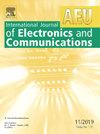ASER analysis of fluid antenna systems with rectangular and hexagonal QAM schemes
IF 3
3区 计算机科学
Q2 ENGINEERING, ELECTRICAL & ELECTRONIC
Aeu-International Journal of Electronics and Communications
Pub Date : 2025-04-01
DOI:10.1016/j.aeue.2025.155792
引用次数: 0
Abstract
In this work, simple approximate average symbol error rate (ASER) expressions are derived for fluid antenna systems (FAS) with rectangular quadrature amplitude modulation (RQAM) and hexagonal quadrature amplitude modulation (HQAM) schemes over correlated Nakagami-m fading channels between a single-antenna transmitter and a mobile device equipped with FAS. Then, asymptotic expressions are also obtained to explore the diversity order of the considered system. All derived expressions are represented only in terms of rational functions and they can be easily computed without requiring any special function computation or L-fold integration. To obtain ASER expressions and overcome mathematical intractability of ASER integrals, a tight approximation of the Gaussian Q function, , is used. The performance of FAS-RQAM and FAS-HQAM schemes are compared with the conventional maximum ratio combining (MRC) technique and it is shown that FAS-QAM systems can outperform MRC systems by providing lower ASER values. In addition, the proposed expressions are not only valid for integer values but also valid for non-integer values of fading parameter and antenna size. Results are demonstrated for different configurations of all parameters and modulation schemes and the approximate results show a good fit to the exact results obtained by using exact in ASER integrals while asymptotic results match well with approximate ones at high signal-to-noise ratio regime. Our approximate results are also found close to the simulation results for both FAS-RQAM and FAS-HQAM schemes.
矩形和六角形QAM流体天线系统的激光激射分析
在这项工作中,推导了具有矩形正交调幅(RQAM)和六边形正交调幅(HQAM)方案的流体天线系统(FAS)在单天线发射机和配备FAS的移动设备之间的相关Nakagami-m衰落信道上的简单近似平均符号误码率(ASER)表达式。然后,得到渐近表达式,以探讨所考虑系统的多样性阶。所有的推导表达式都只用有理函数表示,不需要任何特殊的函数计算或L-fold积分,可以很容易地计算出来。为了获得ASER表达式并克服ASER积分的数学难解性,我们使用了高斯Q函数的严密逼近Q·。将FAS-RQAM和FAS-HQAM方案的性能与传统的最大比组合(MRC)技术进行了比较,结果表明,FAS-QAM系统通过提供更低的激光值来优于MRC系统。此外,所提表达式不仅对衰落参数和天线尺寸的整数值有效,而且对非整数值也有效。结果表明,在各种参数和调制方案的不同配置下,近似结果与精确Q·在ASER积分中得到的精确结果拟合良好,而在高信噪比条件下,渐近结果与近似结果吻合良好。我们的近似结果也与FAS-RQAM和FAS-HQAM方案的仿真结果接近。
本文章由计算机程序翻译,如有差异,请以英文原文为准。
求助全文
约1分钟内获得全文
求助全文
来源期刊
CiteScore
6.90
自引率
18.80%
发文量
292
审稿时长
4.9 months
期刊介绍:
AEÜ is an international scientific journal which publishes both original works and invited tutorials. The journal''s scope covers all aspects of theory and design of circuits, systems and devices for electronics, signal processing, and communication, including:
signal and system theory, digital signal processing
network theory and circuit design
information theory, communication theory and techniques, modulation, source and channel coding
switching theory and techniques, communication protocols
optical communications
microwave theory and techniques, radar, sonar
antennas, wave propagation
AEÜ publishes full papers and letters with very short turn around time but a high standard review process. Review cycles are typically finished within twelve weeks by application of modern electronic communication facilities.

 求助内容:
求助内容: 应助结果提醒方式:
应助结果提醒方式:


